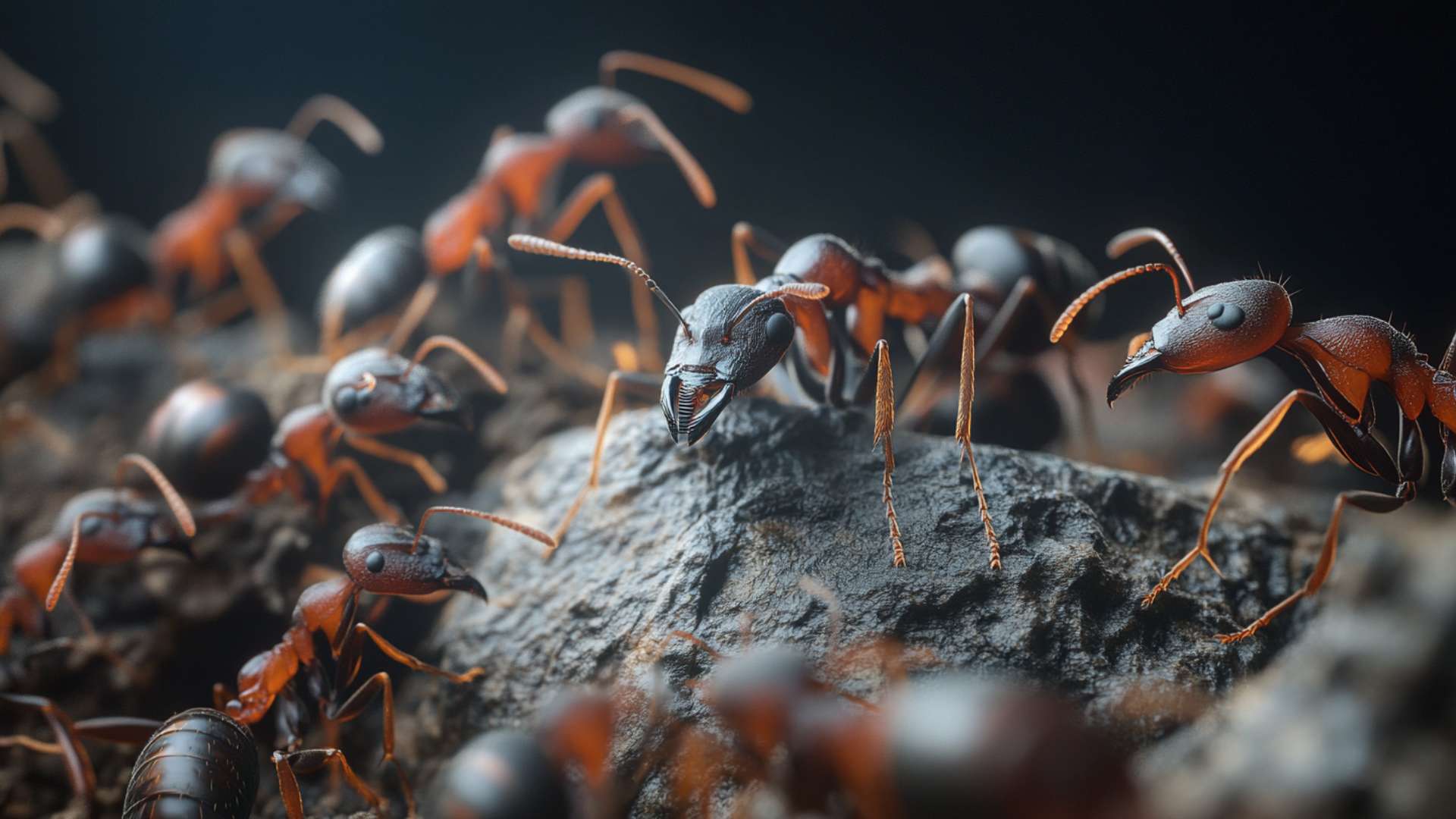Ants: Tiny creatures with fascinating abilities. These miniature ants, with their tireless work ethic and complex social structures, have long captivated our curiosity. But have you ever wondered about their visual prowess?
Do ants have eyes? This article aims to delve into the intriguing world of ant vision and shed light on the remarkable sensory adaptations of these industrious insects.
Exploring the question: Do ants have eyes?
Our understanding of ants has expanded greatly in recent years, thanks to scientific research and technological advancements that allow us to peer into their miniature world. One fundamental aspect that has piqued the interest of entomologists is the visual capabilities of ants. A common misconception is that ants are blind, relying solely on chemical signals for navigation and communication.
However, this oversimplification does not paint an accurate picture. To answer the question at hand, we must first explore the unique eye structure of ants.
Unlike human eyes with a single lens, ants possess compound eyes comprising thousands of tiny lenses called facets. These compound eyes enable them to perceive a fragmented mosaic view of their surroundings rather than a unified image like our own vision.
Ant Vision: The Basics
Compound eyes: The primary visual organ of ants
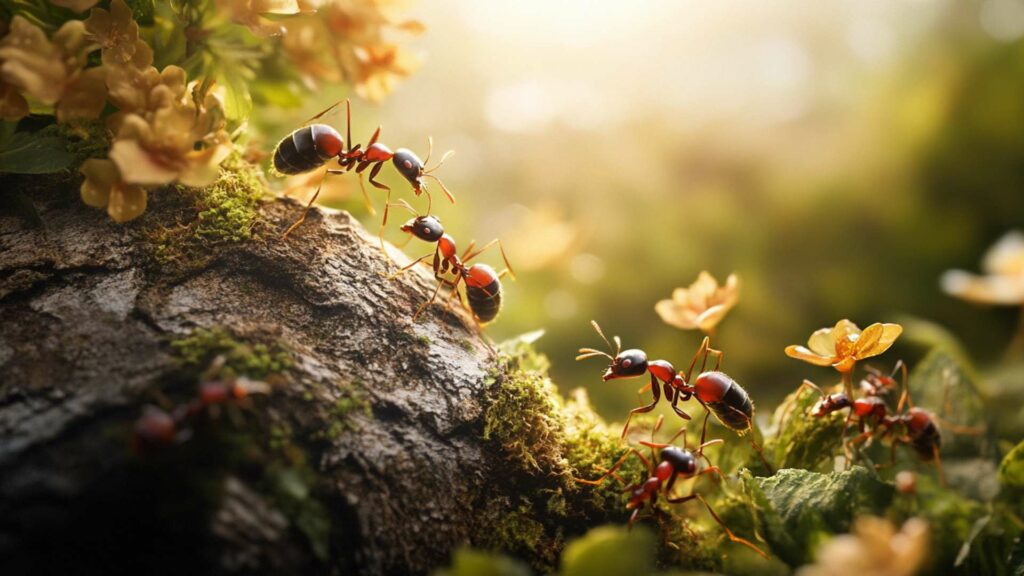
When it comes to ant vision, we must first understand the unique nature of their primary visual organ – the compound eyes. Unlike our own eyes, which are made up of a single lens, an ant’s compound eyes are composed of hundreds (or even thousands) of tiny lenses called ommatidia. Each ommatidium contributes a small piece of the overall visual puzzle, allowing ants to perceive their surroundings in a mosaic-like manner.
The structure and function of compound eyes provide ants with a wide field of vision and an ability to detect movement effectively. While each ommatidium captures only a fraction of the image, the combined input from all these tiny lenses gives ants an impressive panoramic view.
This allows them to scan their environment for potential threats or resources without needing to turn their heads like we do. Although this type of vision results in slightly blurred images due to limited resolution per ommatidium, it compensates by covering a larger area overall.
Unique structure and function of compound eyes
Each ommatidium in an ant’s compound eye consists of a lens that focuses light onto sensory cells called photoreceptors. These photoreceptors convert light signals into neural impulses that are then transmitted to the ant’s brain for processing.
Interestingly, different types of photoreceptor cells exist within each ommatidium, enabling ants to perceive different wavelengths or colors. While most other ants have two large compound eyes positioned on each side of their head, some species have additional simple or “ocelli” located on top.
These three extra eyes contribute less to visual acuity but help with detecting changes in light intensity and maintaining proper orientation relative to gravity. It is important to note that not all ant species possess equally developed compound eyes; some ants may have relatively better vision, while others may be almost completely blind.
The ability to rely on other senses such as chemoreception (through their antennae) or vibrational sensitivity (through their legs) allows ants to compensate for any limitations in their visual perception. In the next section, we will delve deeper into the different types of eyes that ants possess, and how they contribute to an ant’s perception of the world around them.
Types of Ant Eyes
Worker ants: Simple eyes for basic vision
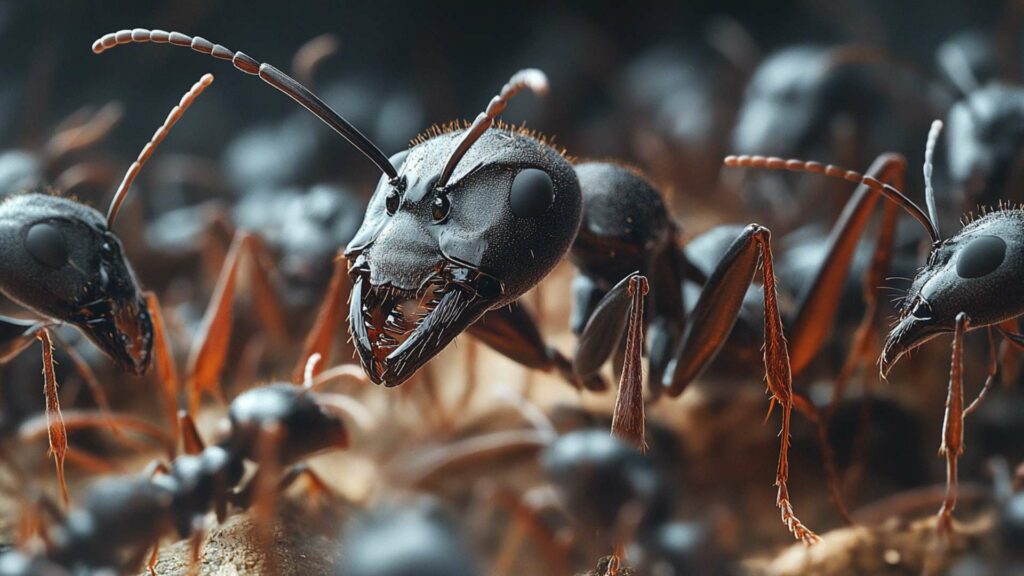
Worker ants, those diligent little creatures that scurry about tirelessly, possess a unique visual system designed to fulfill their essential tasks. These industrious insects have three small eyes, called ocelli, situated on the top of their heads. Though minuscule in size, these ocelli play a crucial role in the ant’s perception of light and dark, enabling them to differentiate between day and night.
However, worker ants’ visual capabilities are quite limited compared to other animal species. Their ocelli lack the ability to form clear images or perceive detailed shapes; instead, they provide rough visual cues necessary for certain visual navigation abilities.
Queen ants: Advanced vision for reproductive needs
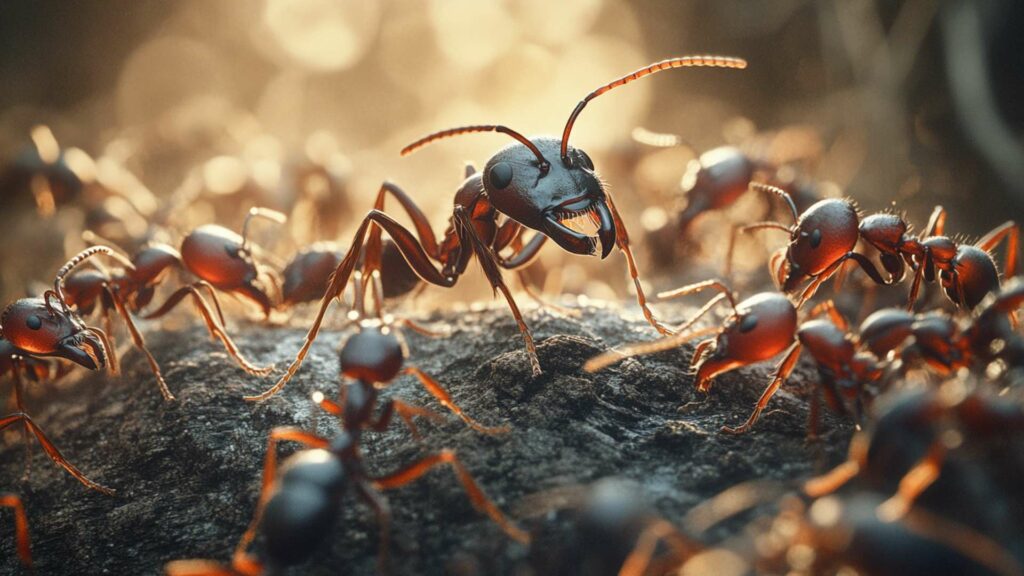
On the other hand, queen ants have evolved more advanced visual abilities that cater specifically to their reproductive duties. Like worker ants, queen ants possess compound eyes resembling those found on worker ants’ heads.
These compound eyes consist of numerous tiny lenses called facets that work collectively to construct an image within the ant’s eye. Unlike worker ants, queen ants’ compound eyes grant them enhanced visual acuity required for critical tasks such as mating and nest establishment.
With their keen vision, queen ants can identify potential mates from a distance and locate suitable areas to establish new colonies. While most ants rely on their compound eyes for basic vision needs, there are distinct differences between worker and queen ant eyesight capabilities.
Workers possess three simple ocelli that provide limited visual information primarily related to light detection and basic navigation cues. Conversely, queens share similar compound eyes with workers but enjoy enhanced visual acuity necessary for successful reproduction and colony foundation efforts.
How Ants Use Their Eyes
Ants are remarkable navigators, relying on their visual abilities to find their way around. They use their compound eyes to detect landmarks and scent trails, which serve as important visual cues for navigation. When exploring the environment, ants pay close attention to distinctive objects or features that help them remember the path back to their nests.
These could be anything from rocks and plants to specific patterns on the ground. Additionally, ants have a remarkable visual memory that allows them to create mental maps of their surroundings.
Hunting and Foraging Strategies Based on Visual Perception
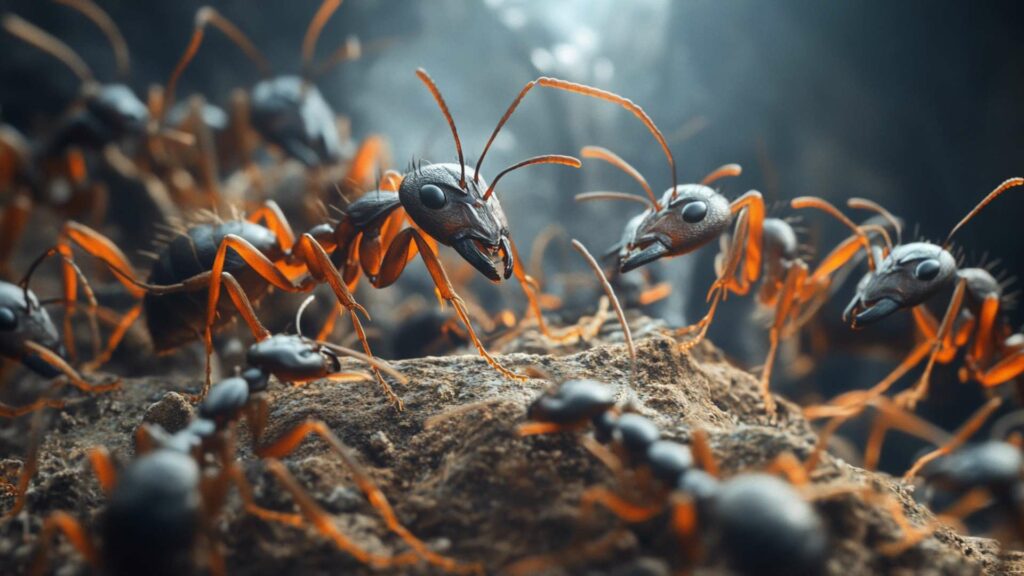
Visual perception plays a crucial role in ants’ hunting and foraging strategies. When searching for food sources, ants utilize their compound eyes to recognize potential targets from a distance.
For instance, if they spot a juicy piece of fruit or a sugary substance nearby, they can quickly identify it and communicate its location with other members of the colony through chemical signals using their antennae. Furthermore, ants rely on their visual acuity to identify prey or potential threats during hunting expeditions.
Whether it’s capturing small insects or avoiding larger predators like birds or lizards, ants have developed keen eyesight that helps them assess the situation accurately. This ability enables them to make split-second decisions about engaging the bigger ants in combat or fleeing from danger.
Through their compound eyes, these ants detect and navigate by detecting landmarks and scent trails while also remembering visual cues for finding their way back home. Moreover, these tiny creatures leverage their visual perception skills for identifying food sources from a distance as well as recognizing potential prey or threats during hunting endeavors
Limitations of Ant Vision
Ants, despite their incredible ability to find their way back to their nests with astounding accuracy, actually suffer from some limitations when it comes to night vision too. Part of the reason for this lies in the size of their eyes. Since ants are such tiny creatures, their eyes are naturally small as well.
This means that they have a relatively low resolution compared to larger animals or flying insects. So while an ant can see objects nearby clearly, its visual acuity diminishes significantly as the distance from the ant’s eye increases.
Imagine looking through a magnifying glass held at arm’s length; the objects you see will appear quite distorted and blurry. That’s pretty much what an ant experiences when it tries to focus robotic vision on things in the distance.
Everything beyond a certain range becomes a hazy blur, making it challenging for ants to discern fine details or recognize objects that are far away. However, ants compensate for this limitation by relying on other senses and using visual cues closer to them.
Inability to perceive certain colors
While humans enjoy the luxury of perceiving a wide range of beautiful colors, ants have a more limited color palette in their visual scape. Ants possess photoreceptors specialized for detecting blue and green light but lack receptors for red wavelengths within the visible spectrum. As a result, they cannot discern red from other colors and perceive it as black or dark gray instead.
Think about how different our world would look if we couldn’t see red: no vibrant flowers, no crimson sunsets – just a muted landscape devoid of one entire color family! For ants, this limitation may impact various aspects of their daily lives; for instance, they may struggle to identify ripe fruits or distinguish between different types of flowers based on color alone.
Nonetheless, nature has its own ways of compensating; ants rely on other visual cues and combine them with chemical and tactile information to navigate their surroundings effectively. While ants, with their compound eyes, possess remarkable visual capabilities within a certain range, they also face limitations.
Their small eye size results in poor long-distance vision, making distant objects appear blurry. Additionally, their inability to perceive red colors restricts their color vision compared to humans.
However, these limitations do not hinder ants from thriving in various environments due to their ability to use other senses and adapt through collective intelligence. Ants may have a different way of seeing the world, but it is no less fascinating or effective for the survival of their intricate societies.
Additional Sensory Adaptations in Ants

Chemoreception: Utilizing antennae for chemical communication
Ants, despite their poor eyesight, have evolved an exceptional ability to perceive and communicate through chemicals. One of the primary means of chemoreception for ants is their antennae. These delicate appendages are equipped with specialized receptors that allow them to detect and interpret pheromones released by other ants.
Pheromones serve as a language for ants, conveying a wide range of messages such as marking trails, signaling danger or attack, or even indicating the presence of food sources. Through this chemosensory system, ants can navigate intricate networks of chemical trails laid down by their fellow workers, ensuring efficient cooperation within their colonies.
Vibrational sensitivity: Detecting vibrations through legs
Beyond chemoreception, ants also possess an astonishing ability to sense vibrations through their legs. This adaptation allows them to perceive subtle changes in their environment and communicate with other members of the colony.
When an ant taps or strums on a surface with its legs, it sends out vibrational signals that can be detected by nearby individuals. For instance, when army ants are on the move, they use this technique to maintain cohesion within their massive groups while raiding other nests.
They create synchronized waves of vibrations that help direct the movement and maintain contact between each member. This vibrational sensitivity is not only useful for communication but also aids in visual navigation ability detecting potential threats or locating hidden prey.
Some nocturnal ants rely heavily on this sense to navigate in low-light conditions where visual cues are limited. By tapping on surfaces and sensing the resulting vibrations traveling through solid objects like soil or tree bark, these nocturnal species can effectively locate food sources or avoid dangers lurking nearby.
While ant vision may be limited with their compound eyes providing pretty blurry vision, ants have evolved remarkable sensory adaptations to compensate for this limitation. Through chemoreception and vibrational sensitivity, ants can effectively communicate, navigate their environment, and engage in complex social behaviors.
These extraordinary abilities continue to captivate scientists and inspire the development of artificial vision technologies that could potentially see artificial vision technology revolutionize various fields. So, next time you encounter a tiny ant scurrying about, appreciate its intricate world of chemical trails and leg-tapping communication that rival even our own sensory marvels.
Evolutionary Significance of Ant Vision
Ants are highly social insects, living in complex colonies where each individual has a specific role to play. Understanding the evolutionary significance of ant vision unveils its crucial role in their social behavior and division of labor.
While some ant species are completely blind, many rely on their eyes for various tasks within the colony. . Eyes do ants have are essential for communication and coordination among ants.
For instance, worker ants with simple eyes use visual cues to recognize and follow scent trails left by other members of larger ant roaming the colony. This helps them navigate back to the nest or locate food sources efficiently.
Furthermore, ants can gauge the size and quality of food using their visual perception, allowing them to prioritize resources and communicate effectively with other workers. Apart from food-related tasks, the ant’s vision is vision also plays a pivotal role in maintaining order within the colony.
When it comes to brood care, worker ants use their eyes to detect larvae that need attention or eggs that need protection from potential threats. This ensures the survival and growth of future generations smaller ants within the colony.
Adaptation to Specific Ecological Niches
The adaptation of ant vision to specific ecological niches is another fascinating aspect highlighting its evolutionary significance. Different species of ants have unique eye structures that suit their particular habitats and lifestyles. Some species exhibit remarkable adaptations related to obstacle avoidance behavior through visual perception.
For example, army ants possess two large, compound eyes positioned at a higher point on their head which provides them with an extensive field of view. This aids them in navigating through intricate forest environments while avoiding obstacles like dense vegetation or fallen debris.
In contrast to smaller ants, fire ants have relatively less vision slightly smaller eyes but possess excellent peripheral vision. This enables them to detect movements from potential predators or rival colonies, giving them a tactical advantage during territorial disputes or defensive situations.
Overall, the evolutionary significance of ant vision is evident in how it contributes to the intricate social behavior and division of labor within colonies, as well as in the adaptation of different ant species to survive and thrive in their specific ecological niches. Understanding these aspects of fire ant species not only broadens our knowledge about ants but also sheds light on the remarkable capabilities of these tiny creatures.
Ants See the World Differently
From examining the role of bull ant’s eye vision in their social behavior and division of labor to understanding how ant’s vision depends on its adaptation to diverse ecological niches, it becomes clear that ants perceive and interact with their surroundings in unique ways. While some species have completely blind individuals relying solely on other senses, many ants heavily rely on their eyes for navigation, communication, and resource acquisition. The diversity within ant species showcases a range of eye structures and visual capabilities tailored to specific requirements.
Whether it is an ant’s eye vision, the complex compound eyes seen in worker ants, or specialized adaptations found in army ants or fire ants, each species has evolved distinct strategies for survival. Ant’s eyes may not provide them with detailed high-definition images like our own eyes do; instead, their vision offers a more blurry vision, yet functional view of the world.
By unraveling this complex visual system and appreciating its significance within an evolutionary context, we gain profound insights into these remarkable insects’ lives. So next time you see walking insects or encounter an ant bustling about its business, take a moment to marvel at how its unique perspective shapes its existence within our intricate natural world.
Fun Facts about Ant Vision
When it comes to the world of ant vision, there is a fascinating fact that puts them in a league of their own. While humans are limited to perceiving only a fraction of the electromagnetic spectrum, some ant species possess the extraordinary ability to detect ultraviolet (UV) light. These tiny creatures have eyes that allow them to see beyond what meets our human eye.
The ultraviolet spectrum is invisible to us, but for ants equipped with this unique characteristic, it opens up a whole new level of perception. UV vision provides ants with valuable information that aids in foraging and navigating their surroundings.
For instance, certain flower petals have intricate UV patterns that guide bees and other pollinators towards nectar-rich sources. Similarly, UV markings on leaves act as visual cues for ants, aiding them in locating potential food sources or even uncovering hidden predators.
So next time you come across an ant meticulously exploring its environment, remember that they may be seeing more than meets your eye! It’s remarkable how these smaller creatures possess such extraordinary visual capabilities.
Conclusion
While ants may not have eyes like ours or our eyes possess highly advanced visual systems seen in some animal species, their unique compound eyes play a significant role in their daily lives. The ant’s eye structure allows them to navigate through complex environments and helps with hunting and gathering food resources efficiently. Understanding the fascinating world of dead ant’s eye vision gives us insight into the remarkable adaptations these tiny creatures have developed over millions of years.
So let us appreciate the humble ants as they scurry around with slightly better vision than we might have assumed. They are masters at utilizing visual cues and making the most out of their surroundings.
Next time you spot an army of busy ants marching together or marvel at the organized chaos within an anthill, take a moment to appreciate the collective intelligence and ingenuity that comes from their unique abilities. After all, ants remind us that even in a world full of giants, there is much we can learn from the smallest of creatures.
Deter Ants with D-Termination: Las Vegas’ Top Pest Control Solution!

If you’re dealing with ant problems, look no further. D-Termination is ready to assist. Our skilled team specializes in discouraging ants, revitalizing cleanliness, and preserving the integrity of your surroundings. Bid farewell to ants—opt for D-Termination for highly effective pest control today!
Contact us at 702-919-6310 or visit dtermination.com to schedule your ant control service and regain your space from these unwelcome pests.
Frequently Asked Questions:
Ants can detect the presence of larger objects, but their vision is limited.
Yes, ants have eyes, but they are relatively simple and don’t provide detailed vision.
Ants are considered visually limited, but not completely blind.
Ants can perceive light and dark, but their vision is quite basic.

